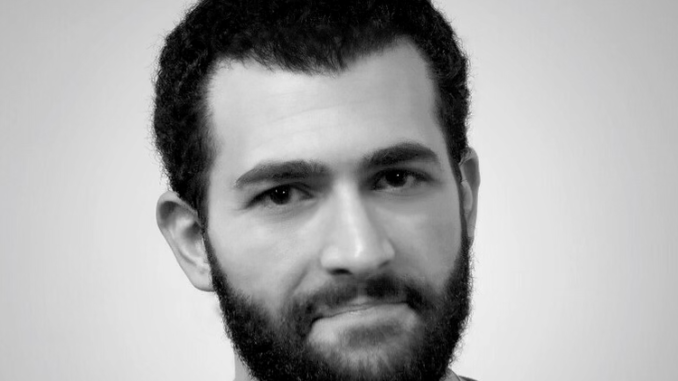
Review Fix chats with director Louis Sayad Caprio, who discusses his newest film, “A Syrian Woman.â€
Review Fix: Why is the topic of this film important today?
Louis Sayad Caprio: Too often in the news are Syrians are referred to as numbers and figures. Khawla and I wanted to make something that approached those enduring this crisis from a place of compassion and understanding and to remember these are real people going through this. And the experience of displacement is not unique to the Syrian war – this is a rapidly growing global issue.
Other stories have focussed on the physical journey that refugees take. This film takes a look at the hurdles of what comes next, where the real longterm struggles begin for most. What are the consequences of simply being a refuge? What are the new challenges that manifest from this displacement? One aspect of the situation we came to understand is that the crisis represents a moment of generational change. Many families have left Syria without their male partners, brothers, and fathers, and a major consequence of this is that many women are becoming the primary providers and decision-makers for themselves and their families for the first time. An image emerged of a new generation of Syrians raised solely by women as the heads of the household. Its an important aspect that’s been largely underreported.
Review Fix: What inspired this film?
Caprio: Khawla and I met while both working on a separate project for Columbia University’s ASPIRE Women’s Project, a research program dedicated to understanding and addressing the health needs of Syrian women refugees living in Jordan. We began to understand how truly large a gap exists between the short, standard “refugee†reports in the media and the stories of these women, so we set out to share the very personal and intimate accounts of their journeys. We wanted to understand their trauma but highlight their optimism, resolve, and strength. After partnering with UNICEF USA and UNICEF Jordan, who gave us tremendous support and access to the local population, we felt we had not just an opportunity but an obligation to give voice to these women.
Review Fix: How difficult was this film to put together?
Caprio: I’ll speak on the editing in this regard, as this turned out to be our largest challenge. We came into the interviewing process with a strong sense of the central themes and concepts we wanted to explore, but our approach to the material evolved constantly as we found more women willing to participate and the scope of our intentions grew. We had to rediscover the film with each new interview, constantly as we shot it, and then all over again in the editing room. Essentially, we shot much more footage than what made the final cut, and we have so much compelling material that we didn’t end up using. Ultimately we wanted the film to touch on many topics in a very short span of time, but also explore the universal themes shared by these radically different stories, so it was important for us to achieve a balance between focus and nuance. Our amazing team of producers Liz Charky, Nagham Osman, and our editor Hany Hawasly all deserve a lot of credit for their efforts in shaping the final piece.
Review Fix: Tell me about the 8 individual women in the film and how you came across them?
Caprio: I reached out to UNICEF as a member of their NextGen community, a group of young leaders and entrepreneurs committed to supporting UNICEF’s work. They helped us reach families in the largest and the most remote refugee camps. As a local producer, Khawla also had a lot of her own resources. She sought out others in primarily-refugee neighborhoods across northern Jordan. We wanted to be with them wherever they felt most comfortable and empowered, and once trust was established it became somewhat easier to identify interview prospects. Every day, we would get in the car and drive from one province to another, eager to meet someone new.
Everyone we spoke to had very diverse backgrounds and experiences. Many of the younger women were focused on education and career possibilities, while the senior women, often the heads of families, stressed protection for the children and economic stability as high priorities. All had to grapple with the challenges and dangers of being women in a traditionally male-dominated society. In the last sequence of the film, 18-year old Bodoor describes what she now believes defines “a Syrian woman†– really, these comments could be referring to women in any part of the world.
Review Fix: Referring to the previous question, did the women find it difficult to be open about their lives and vulnerable on camera?
Caprio: At first, it wasn’t the easiest task at first to find women willing to be on camera. Many women were hesitant over the conservative cultural stigma of being shown on-screen; some feared their loved ones who remained in Syria might face repercussions for their having participated; others were tired of their depiction in foreign media; some weren’t interested in revisiting their trauma. So the request to film was initially met with skepticism. But before the camera was ever introduced, Khawla and I took a lot of care to assure each of our subjects that our intentions were genuine. We made every effort to ensure that our subjects felt safe, protected and comfortable sharing on camera, and we’re extremely thankful for all those that did. It was particularly important on this shoot, we felt, to have a tight-knit and predominately female crew that was local to Amman. I think that made a big difference. As it turned out: for however many individuals who said they wanted to avoid their trauma, there were countless more who were still deeply preoccupied with it and looking to share. It was a major catharsis for some.
Review Fix: How have the audiences been reacting to A Syrian Woman?
Caprio: The response has been incredibly positive, so far. Recently we screened at Big Sky Documentary Film Festival, where we also had the added opportunity to share the film with a high school class in Montana. This young audience was worlds apart from the film’s subject matter, but seeing how they were able to emotionally connect was powerful. It’s been one of my favorite experiences sharing the film. I recall one young man in the class say, “In a lot of ways, they seem just like us,†referring to high school classmates and adding, “What would it be like if I lost my home tomorrow?†For me, that’s a powerful take-away that I hope continues to resonate with others. People want to know how they can help.
Review Fix: What have you learned about yourself through this entire process?
Caprio: This project has been a life-changing experience for Khawla and me, and the community we’ve met along the way has moved me to tell more personal and impactful stories in the future. Before this project, I had primarily worked in more scripted and commercial media. The Syrian crisis hit close to home – as my mother is Syrian in background – and I wanted to help. I’m finding that I enjoy both documentary and narrative filmmaking and that these different formats can inform each other. Whatever the medium, I gravitate towards stories that explore memory, place, identity, and adaptation. I feel this experience has shown me that I have a unique perspective and approach to those themes.
Review Fix: What’s next?
Caprio: Like I mentioned before, the material in this short is only a small piece of the material we shot. We’re currently cutting some companion pieces in conversation with the film to be shared online through our new website. They’ll provide more in-depth stories of our featured subjects as well as others whose stories have yet to be shared. It’s an invitation to learn more about the women, their families, and where they are now through that upcoming online experience.
Separate from “A Syrian Woman,†there are a few new projects, documentary and scripted, currently in works with another project possibly beginning this summer in the Middle East – fingers crossed. For now, you can check out the film’s website, asyrianwoman-film.com, where you can connect with us and learn more. You can also follow our Instagram @asyrianwoman and stay updated on where we’ll be sharing the film next.
Review Fix: Anything else you’d like to add?
Caprio: The women in the film stand as role models for the next generation, carrying hope in the midst of incredible adversity. They are capable and ambitious trailblazers, and the film is a celebration of their resilience. At the same time, they need resources and support to succeed and survive. And more so now than ever before with the coronavirus pandemic at their doorstep, making an already dire situation even worse. Many who’ve already seen the film have asked how they can get more involved. Our film’s website highlights a few organizations on the frontlines, including UNICEF. The work they do is truly astounding. They can make a difference for countless lives with the right support.


Leave a Reply